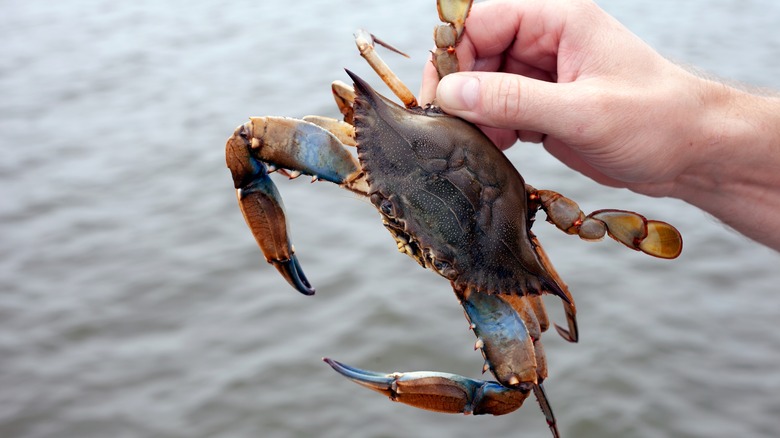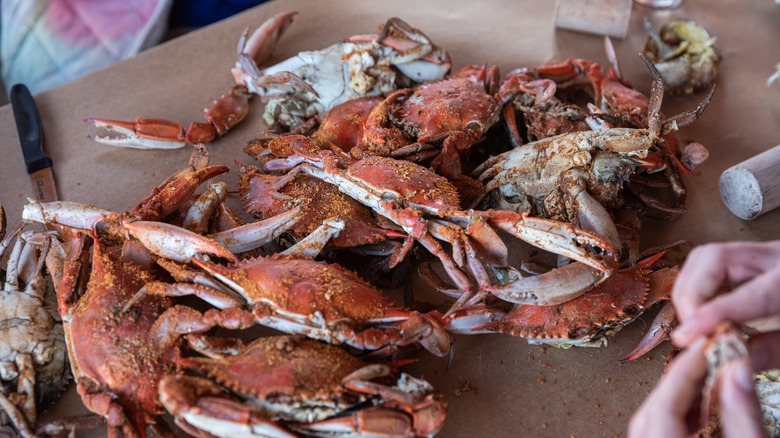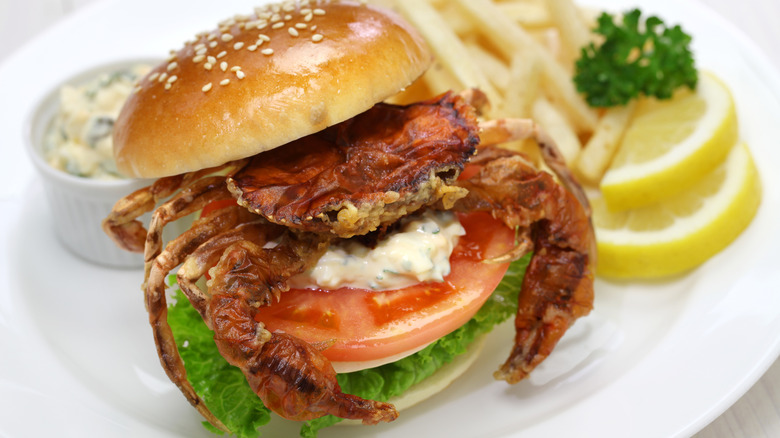What Makes Maryland Blue Crabs Taste So Different?
What crawfish is to Louisiana, and lobster is to Maine, blue crab is to Maryland. The crustacean is synonymous with the Chesapeake Bay, and is revered for its delicate and distinct flavor. While blue crabs can be found up and down the Atlantic coast, from Canada to Argentina and into the Gulf coast, any crab connoisseur will tell you Maryland blue crabs reign supreme — and in fact, about half of all blue crabs harvested in the U.S. comes from Maryland.
Acclaimed chef José Andrés prefers this region's crabs, and the explanation behind their delicious flavor comes down to climate. Maryland blue crabs undergo a period of dormancy — a lighter form of hibernation — in the winter months. They are more sensitive to colder temperatures, so once the water begins to turn chilly, they swim out to deeper parts that remain at temperatures above freezing. They then bury themselves in the mud or sand to stay warm and safe from predators. The crabs also accumulate fat reserves in preparation for this dormant period, which lends to richer, sweeter-tasting meat that tastes unique compared to other types.
All crabs have fat stores in their body, known in culinary terms as tomalley, which is a coveted delicacy to many. These innards can even be used as a flavorful butter upgrade. The tomalley in Maryland blue crabs is a golden hue and comes with a much deeper flavor, thanks to their time in winter dormancy.
Types of Maryland blue crabs
There are a few types of Maryland blue crabs, each with its own unique characteristics. The male crabs, known as Jimmies, come in subcategories called number one or number two. The number one Jimmy is larger and perfect for steaming and eating right out of its shell. Number two Jimmies have just finished shedding their hard shells, a process known as molting, and are therefore smaller. These are best enjoyed whole (with no need to peel them), or they may be sold as lump crab meat.
The females are divided into Sooks, Sallies, and Sponges, depending on their maturity level. Sooks are fully grown and are often steamed, much like a number one Jimmy. Although they have less meat than their male counterpart, Sooks tend to be sweeter and denser. Sallies are younger and therefore smaller, and contain less meat than Sooks. Sponges are females that have mated, meaning they're filled with tasty roe; up to two million eggs might be present in one crab.
Maryland blue crabs get their name from their bright blue claws, but these turn red once cooked. They're are in season from April through November, with the summer being the peak period for crab feasts. However, the crustaceans at their most bountiful after their dormancy come spring, and the largest and meatiest crabs can be found during the fall. Their fat stores will likely be at their richest at this point, as they prepare for the winter months.
How to enjoy Maryland blue crabs
Another reason why Maryland blue crabs may taste better lies in how they are prepared. Many cooks around the globe boil their crabs, but in the Chesapeake Bay, steaming is the most popular method. Marylanders believe boiling the meat causes the flavor to leak out into the water, while steaming keeps the juices intact inside the shell.
Wondering about the difference between hard shell and soft shell crabs? All crabs shed their shells, so any given crab can either be a hard or soft shell; it just comes down to how much they've molted by the time they're harvested and sold. Hard shell crabs are usually best steamed, cracked open, and eaten as-is. The meat is also often turned into lump crabcakes or crab salad. Soft shell crabs are typically battered, fried, and eaten as a sandwich with a remoulade sauce. Marylanders also use the meat to make tomato-based crab soup, chock-full of vegetables like potatoes and corn, plus a healthy dose of Old Bay seasoning.
The ultimate celebration of crab, a traditional Chesapeake crab feast, involves steaming hard shells and cracking them over a newspaper-lined table. The crabs are typically enjoyed with a dash of Old Bay, a side of corn, and a beer. A mallet is used to break the shells open, but your hands are the best tool to extract the meat. Be prepared to get them dirty; licking your fingers is just another way to savor all the flavor.



